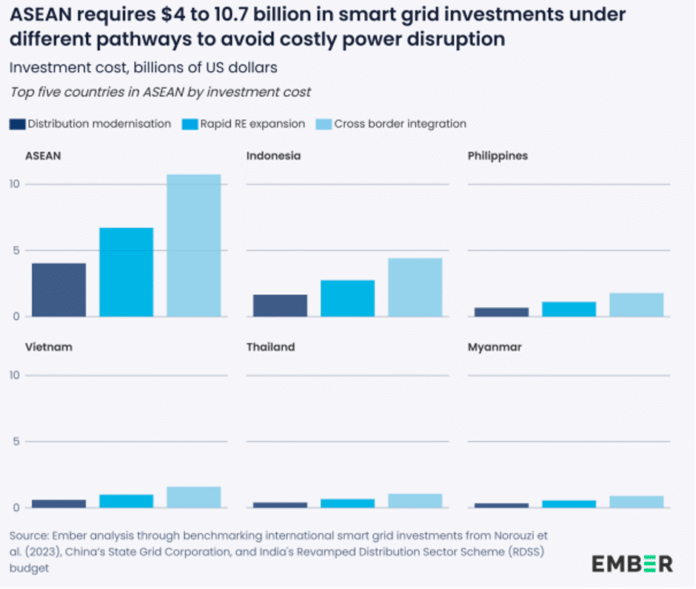ASEAN countries could avoid $2.3 billion in economic losses by 2040 by modernizing their electricity networks to keep pace with surging power demand and renewable energy growth, according to a new report by Ember. The study highlights that investments between $4 billion and $10.7 billion in smart grid infrastructure are crucial for ensuring reliable, efficient, and future-ready electricity systems across Southeast Asia.
At the lower investment level — around $4 billion — ASEAN nations could implement essential upgrades such as smart meters, automated controls, and digital monitoring systems to improve reliability. The upper investment range of $10.7 billion would enable fully optimized smart grids, supporting advanced energy storage, cross-border interconnections, and real-time digital management of renewable power.
Smart Grid Development Across ASEAN
Major investment needs lie in large, fast-growing economies such as Indonesia, Vietnam, and the Philippines, where frequent outages continue to impose high costs. Singapore and Malaysia are already ahead, demonstrating successful models of digital grid modernization. This variation across the region underscores opportunities for knowledge-sharing and regional collaboration.
Between 2015 and 2020, ASEAN achieved a 60 percent reduction in outage duration and frequency, but Ember notes that financing gaps, fragmented standards, and uneven policy commitments still hinder full-scale smart grid adoption. Many power systems remain constrained by rigid demand patterns and limited digital tools like time-of-use tariffs and smart appliances.
Why Smart Grids Matter for ASEAN’s Energy Transition
Smart grids use sensors, automation, and data analytics to balance electricity supply and demand in real time. Unlike conventional upgrades that simply add capacity, smart grids integrate generation, transmission, and consumption — enabling higher renewable energy penetration, improved efficiency, and system resilience.
“Smart grids are no longer optional — they are the backbone of ASEAN’s clean energy future,” said Alnie Demoral, Energy Analyst at Ember. “Investing in smart grid infrastructure is both an enabler of the energy transition and a driver of economic competitiveness.”
Countries such as Singapore, Malaysia, Thailand, the Philippines, Indonesia, and Vietnam have launched smart grid initiatives, including smart metering pilots, demand response programs, cybersecurity frameworks, and curtailment reduction projects. These efforts signal growing momentum toward digitalized, resilient power systems across the region.
Economic and Social Benefits
Ember’s analysis suggests that smart grid investments could create between 243,000 and 649,000 new jobs, spanning engineering, construction, IT, and long-term operations. Reliable, cleaner electricity systems would reduce dependence on diesel backup generators, lower household energy costs, and improve public health by reducing air pollution.
The Path Forward
To realize these benefits, ASEAN governments must harmonize standards, mobilize financing, and coordinate regional strategies. Enhanced cooperation could unlock shared opportunities in energy efficiency, technology innovation, and emissions reduction.
“Smart grids are an essential tool for managing increasingly complex energy systems in ASEAN and the wider Asia-Pacific,” said Carlos Kuriyama, Director of the APEC Secretariat’s Policy Support Unit. “They reduce waste and pollution while maximizing the efficient use of energy infrastructure. Regional cooperation will be key to realizing their full potential.”
With the right policy and investment framework, ASEAN can transform its power networks into digitally intelligent, renewable-ready systems, avoiding billions in economic losses while powering sustainable growth in the low-carbon economy.
Baburajan Kizhakedath

